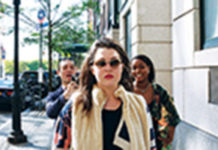From May 6 to May 12, the Sustainability Office is holding their second annual BioBlitz. The BioBlitz is a series of events where people are invited to come out and record the many plant and animal species all around campus. According to Mat Thijssen, director of sustainability, the BioBlitz is also an excellent way to “give students an opportunity to explore the campus and get outside […] We also think it’s important for people to connect and learn about the campus around them, we’re not the only inhabitants of the land we’re working, living and learning on.”
On May 6, a community fair was held in the SLC. The community fair was a chance for the local organizations around Waterloo to meet with students. The organizations that attended were the Sustainability Office, the Ecology Lab, the Canadian Wildlife Federation, Rare Charitable Research Reserve, UW Society for Ecological Restoration and the UW Entomology Club.
From May 6 to May 10, there were a series of guided walks lead by various experts on certain species.
On May 6, professor Liam McGuire led a guided walk for birds, allowing people to identify them based on both sight and song. Later the same day, Waterloo alumnus Emily Trendos guided the insect walk.
The amphibian walk was hosted on May 7 and was led by Nathan DeCarlo, a senior ecologist at environmental consulting company William Sale Partnership (WSP). During this walk, DeCarlo spoke about how frogs are a good indicator of ecosystem health which is why their habitats are protected under legislation. There are four frog species that can be seen on campus which are the Northern Leopard Frog, American Toad, Green Frog, and Grey Tree Frog.
The guided walk for bats, moths and plants occurred on May 8. Professor Liam McGuire showed how people could identify moths and detect bats with different equipment. Riley Jauniaux, a junior terrestrial ecologist at WSP, helped attendees learn how to identify plants, especially ones that only appear in spring.
On May 9, Bev Raimbault from the Ecology Lab organized the mushroom guided walk. Finally on May 10, Patricia Huynh, the sustainability projects manager, conducted the aquatic insects walk in Laurel Creek.
The BioBlitz also organized two tree planting events for people to be able to aid in restoration efforts of nature on campus. In addition, for the duration of the entire BioBlitz, the community can take photos of the many species they find around campus and upload them to iNaturalist for a chance to win prizes.
“We’ve identified 241 types of species in the first couple of days,” Thijssen said. “There are over 1,700 different species that have been identified across the University of Waterloo.” This is thanks to the iNaturalist platform as well as the combined efforts of the community, showing the massive amount of biodiversity around UW.
Thijssen mentioned that the identification of various species serves another crucial purpose to biodiversity — it allows the Sustainability Office to find out which species are endangered or invasive. This would result in intervention from their grounds team, with the goal of improving the natural environment around campus. Thijssen commended BioBlitz for being able to show the Sustainability Office which areas needed conservation or remediation efforts. For example, they have removed buckthorn and garlic mustard from campus, as those are invasive species. They also found places that need more naturalization, which are the focus of the tree planting event.



























